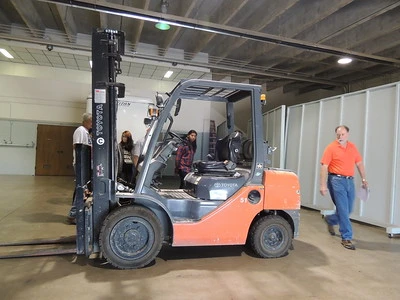5 Most Common OSHA Citations Involving Forklifts
February 26, 2024 | by onlineoshasafetytraining.com


1. Unsafe Operation
- Description: Unsafe operation of forklifts encompasses actions or behaviors by operators that increase the risk of accidents or injuries in the workplace. This includes a range of practices that violate OSHA’s safety guidelines.
- Examples:
- Driving at excessive speeds or in a reckless manner.
- Operating a forklift with an obstructed view of the path of travel.
- Carrying loads that exceed the forklift’s rated capacity.
- Elevating personnel without the proper safety equipment or platform.
2. Failure to Provide Refresher Training
- Explanation: OSHA mandates that all forklift operators receive adequate training and evaluation on the safe operation of powered industrial trucks. This includes refresher training under specific circumstances to ensure operators maintain their competency.
- Importance: Refresher training is crucial when:
- An operator has been involved in an accident or near-miss incident.
- There is evidence of unsafe operation by the operator.
- A different type of forklift is introduced to the workplace.
- Changes in the workplace environment could affect safe operation.
3. Missing/Inadequate Operator Certification
- Details: Certification ensures that forklift operators have been trained and evaluated according to OSHA standards. This process includes both theoretical knowledge and practical skills assessment.
- Consequences: Operating a forklift without proper certification can result in citations from OSHA, increased risk of workplace accidents, and legal liabilities for the employer.
4. Failure to Remove Unsafe Trucks from the Service
- Guidelines: Regular inspections must be conducted to identify any defects or conditions that could make a forklift unsafe to operate. This includes mechanical issues, structural damages, or any other condition that fails to meet safety standards.
- Procedures: Unsafe forklifts must be immediately removed from service until they are repaired to a condition that meets OSHA’s safety requirements. This involves documenting the defect, notifying appropriate personnel, and ensuring the forklift is not used until it is safe.
5. No Pre-Operation Inspection
- Importance: Conducting pre-operation inspections is vital to identify potential hazards or mechanical issues that could lead to accidents. These inspections help ensure the safety of the operator and others in the workplace.
- Checklist Items:
- Examination of tires, horns, brakes, backup alarms, and steering mechanisms.
- Verification of the correct functioning of lift and tilt mechanisms, as well as load stability features.
- Checking fluid levels (hydraulic oil, brake fluid) and the condition of the battery and charging apparatus for electric trucks.
- Inspection for any visible damages to the forks, mast, and overhead guard.
Incorporating technical terms such as “rated capacity,” “powered industrial trucks,” and specific OSHA standards (e.g., 1910.178) can provide clarity and emphasize the regulatory and technical aspects of forklift operation and safety.
Why You Need to Know These Common Citations
Knowing the most common OSHA citations for forklifts is super important, and here’s why it matters in plain talk. Keeping everyone safe is at the top of the list because knowing what usually goes wrong with forklifts lets us find and fix hazards before they cause accidents.
No one wants to end up hurt, so understanding these common errors is crucial for keeping everyone at the workplace safe. Then there’s the money aspect. OSHA fines can be hefty, and being aware of what they’re looking out for can save a lot of money that would otherwise go toward paying penalties.
This knowledge also makes for better training since you’ll know exactly what mistakes to avoid, ensuring that everyone is well-informed on how to operate safely and efficiently.
Focusing on these slip-ups also shows that safety is a priority, which creates a better, more productive environment for everyone. Plus, it keeps operations running smoothly because accidents can really slow things down, affecting everything from daily tasks to order fulfillment.
Having a solid safety record not only looks good but also tells customers and partners that you’re committed to doing things the right way, potentially leading to new business opportunities. Lastly, staying on top of these common citations means you’re less likely to run into trouble with OSHA, making your workplace safer and smarter.
All in all, understanding the most common forklift citations is a smart move for protecting your people, your finances, and your business altogether.
Consequences of Non-Compliance with OSHA Forklift Regulations
Overview of Penalties and Fines
Non-compliance with OSHA standards for forklift operation and safety can lead to significant penalties and fines. OSHA’s penalty structure is designed to motivate compliance and ensure workplace safety. As of my last update in April 2023, OSHA penalties were as follows:
- Serious, Other-Than-Serious, and Posting Requirements Violations: For each violation, the maximum penalty can reach up to $14,502.
- Failure to Abate: If an employer fails to rectify a cited hazard, they can be fined up to $14,502 per day beyond the abatement date.
- Willful or Repeated Violations: The maximum penalty for willful or repeated violations can soar up to $145,027 per violation.
These amounts are subject to adjustment for inflation and may vary based on the severity of the violation, the company’s history of previous violations, the size of the business, and other factors.
Impact on Workplace Safety
Non-compliance with OSHA’s forklift regulations can significantly impact workplace safety, leading to increased risk of accidents and injuries. Forklift accidents can result in severe consequences, including:
- Physical Injuries: Operators and bystanders can suffer from a range of injuries such as fractures, crush injuries, or even fatalities, especially in cases of forklift overturns or collisions.
- Property Damage: Unsafe operation or failure to properly maintain forklifts can lead to substantial property damage, affecting warehouse infrastructure, goods, and the forklifts themselves.
Financial Well-being
Beyond the immediate penalties and fines, non-compliance can have a profound impact on a company’s financial well-being:
- Increased Insurance Premiums: Companies with a history of safety violations often face higher insurance premiums as they are considered higher risk.
- Legal Costs: In the event of accidents, companies may face legal costs from lawsuits filed by injured parties.
- Repair and Downtime Costs: Accidents can lead to costly repairs for damaged equipment and infrastructure, as well as operational downtime affecting productivity and revenue.
- Reputation Damage: Safety violations can damage a company’s reputation, affecting customer trust and potentially leading to lost business.
Ensuring compliance with OSHA forklift regulations is not just a legal obligation but a critical component of maintaining a safe workplace, protecting employees, and safeguarding the company’s financial and reputational well-being. Regular training, equipment inspections, and adherence to safety protocols are essential strategies to avoid the negative consequences of non-compliance.
Preventative Measures and Best Practices
Implementing strategic preventative measures and adhering to best practices are crucial for avoiding common forklift-related OSHA citations. These strategies focus on enhancing workplace safety, ensuring compliance with regulations, and minimizing the risk of accidents and injuries. Below are key approaches and practices in achieving these goals:
1. Comprehensive Safety Training
- Initial and Refresher Training: OSHA requires that all forklift operators receive proper training and evaluation before operating equipment. This includes both theoretical knowledge and practical skill assessments. Additionally, refresher training is necessary at least once every three years, or sooner if the operator is involved in an accident, observed operating the vehicle unsafely, or when changes in the workplace or the type of forklift used present new hazards.
- Content of Training Programs: Training programs must cover topics such as vehicle operation, load handling, vehicle maintenance, and understanding of the workplace environment where the forklift will be used. The use of interactive and practical training methods, including simulations and hands-on evaluations, can enhance learning outcomes.
2. Rigorous Equipment Maintenance
- Regular Inspections: Conduct daily or pre-shift inspections of forklifts to check for issues such as tire condition, brake performance, and proper functioning of controls and safety devices. Use a standardized checklist that includes all critical components as outlined by the manufacturer and OSHA standards.
- Preventive Maintenance Schedule: Follow the manufacturer’s recommended maintenance schedule to ensure all components are in optimal working condition. This includes regular servicing of the hydraulic systems, lifting mechanisms, electrical systems, and any safety features.
- Documentation: Keep detailed records of all maintenance, inspections, and repairs performed on each forklift. This documentation can help in identifying recurring issues and ensuring compliance with OSHA’s requirements for equipment safety.
3. Safe Operation Protocols
- Load Handling: Ensure operators are trained in safe load handling techniques, including checking load stability, weight distribution, and securement. Operators should be familiar with the forklift’s load capacity and the risks associated with overloading.
- Workplace Environment Adjustments: Modify the workplace environment to reduce forklift-related hazards. This can include improving lighting, installing mirrors at blind spots, and designating specific pathways for forklift traffic.
- Speed Limits and Traffic Controls: Implement speed limits for forklift operations within the facility and use signage or floor markings to clearly indicate these limits, as well as any designated pedestrian areas.
4. Emergency Preparedness and Response
- Accident Reporting Procedures: Develop and communicate clear procedures for reporting accidents and near-miss incidents. This encourages a culture of safety and accountability, and provides data for improving safety measures.
- First Aid and Emergency Response: Ensure access to first aid supplies and trained personnel. Conduct regular drills for emergency response, including forklift-related accidents, to prepare employees for real-life scenarios.
By integrating these preventative measures and best practices into daily operations, organizations can significantly reduce the risk of forklift-related accidents and OSHA citations. It emphasizes the importance of proactive safety management, continuous training, and equipment maintenance in creating a safer workplace.
To Make a Conclusion
Dealing with forklifts at work is more than just ticking boxes on a safety checklist. The common mistakes that lead to OSHA calling out businesses are really wake-up calls about how crucial it is to keep things safe.
By learning from these slip-ups and sticking to the safety rules, workplaces can cut down on accidents big time. It’s all about keeping everyone safe and sound, dodging hefty fines, and making sure everyone gets to clock out safely at the end of the day.
So, let’s take these lessons to heart, look out for one another, and make safety the top priority every day. That way, we’re all in for a safer tomorrow.
RELATED POSTS
View all

